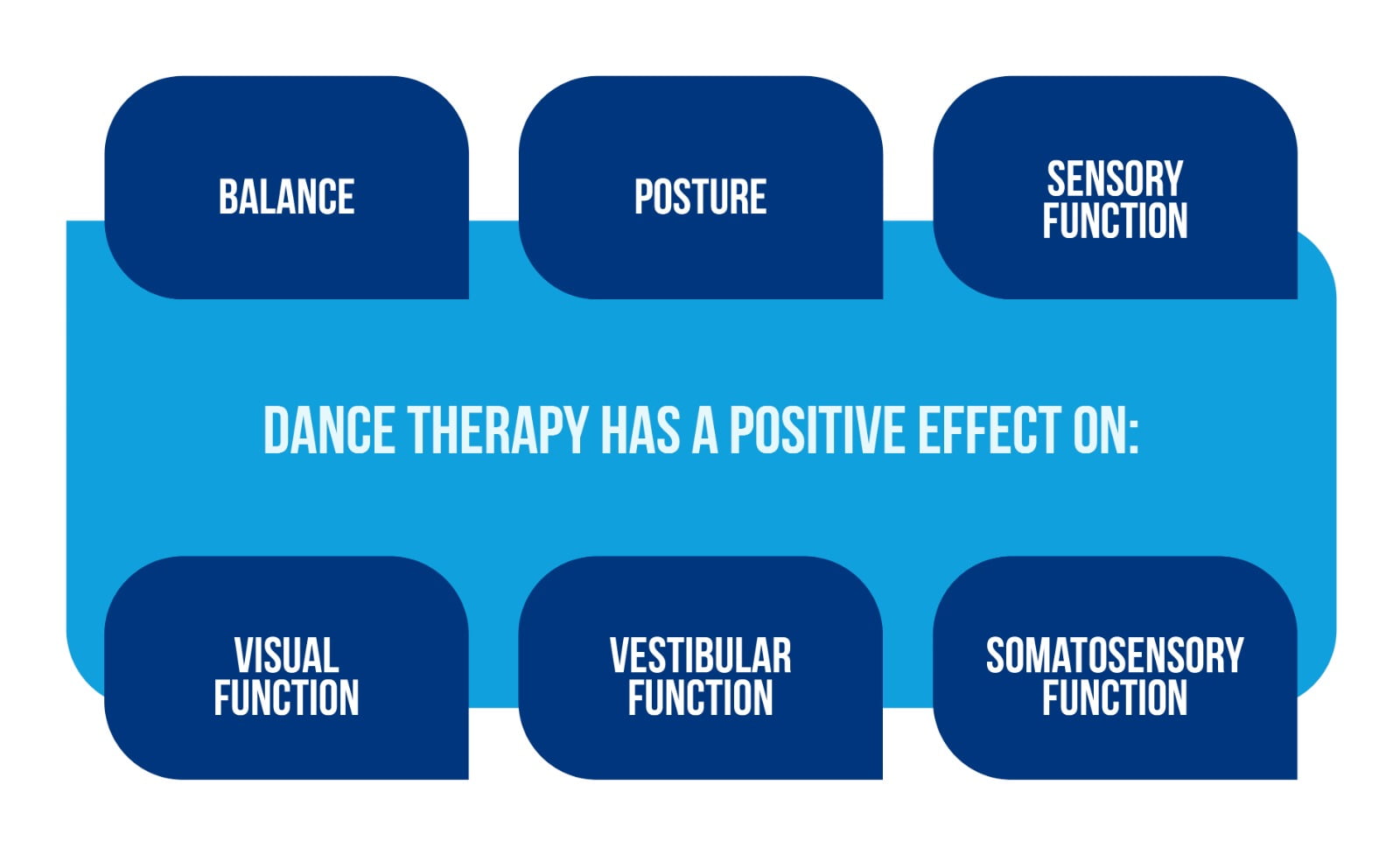Can we change the brain through dance?

Authors: Ioana Stanescu, Oana Vanta
Keywords: dance, motor behavior, brain plasticity, cognitive function
Can we change the brain through dance?
Can our brain change its structure in adult life? Our brain networks can change in response to new information, specific stimulation, or after damage. The process is called neuroplasticity. This process is very intense during brain development when new synapses and neuronal connections are made, but it is also involved in learning and memory. Neuroplasticity compensates for the lost functions in brain damage by creating new neuronal networks.
The adult brain can change and modify its function and structure in response to stimuli from inside or outside the body, such as traumatism or stroke. Neural plasticity is more than functional adaptation; it implies connections change and structural reorganization of the brain [1].
However, neuroplasticity has limitations: damage to critical areas of the brain cannot be compensated by functional and structural reorganization of other areas, so the recovery of the lost function is only partial.
Brain plasticity can be improved through various paths of action (Figure 1).

It has been demonstrated that learning or practicing motor tasks increases specific brain networks’ activity.
Dancing is a complex activity for the brain
Dance is a combination of movement, rhythm, sound, dexterity, and artistic creativity. The performance of complex movements requires the activation of brain areas with the following functions:
- motor
- sensory
- auditory
- cognitive
Dance benefits physical activity, balance and posture, and cognitive functions, such as memory, spatial recognition, decision-making, stress reduction, and social interactions [2].
Dance is a rhythmic activity, a synchronization between external and internal rhythms, associated with the expression of gestural and emotional representations. Moreover, it has been used as a form of language, creating interpersonal connections.
Dance can integrate different brain functions: proprioception (perception of the body movements), musical perception, and emotional interpretation and expression. Also, watching the movements of other people activates “the mirror neurons” from observation and simulation networks.
In professional dancers, less neuronal activation of the motor networks is needed to perform a motor task [2].
How can we assess the dance effect on the brain?
The effects on the brain are showcased in structural changes, functional reorganization, and cognitive functions.
In a study, dance therapy was used in healthy seniors, persons with mild cognitive impairment, or patients with psychosis. Patients practiced different dance styles:
- Social dance
- Waltz
- Salsa
- Rumba
- Cha-cha
- Blues
- Tango
- Jitterbug
- Line dance
- Jazz
- Rock`n`roll
- Square dance.
Control interventions included sports, aerobic exercises, walking, playing instruments, and health education. The assessed parameters were structural (brain structure changes detected by Magnetic Resonance Imaging (MRI), functional MRI (fMRI), or Diffusion Tensor Imaging (DTI)), and cognitive (cognitive functions) [2].
Is it possible to change the brain through dance?
The complex movements required by dance activate motor, somatosensory, and cognitive brain areas from both cerebral hemispheres. It stimulates the neuroplasticity processes and induces changes in the gray and white matter structure. An increased volume in cortical areas involved in motor behavior (precentral gyrus, supplementary motor area) and memory (hippocampus and parahippocampal gyrus) was noticed after training. Sensory stimulation might induce these changes during complex sensorimotor dance tasks [3]. Greater volume has been observed in other cortical areas of the:
- frontal lobe (cingulate gyrus, left medial frontal gyrus, left insula)
- temporal lobe (left superior temporal gyrus)
- parietal lobe (left postcentral gyrus) [4].
After six months of training, an increase in volume can be observed in the white matter of the frontal and parietal areas. An important augmentation of the corpus callosum, which connects the two cerebral hemispheres, was also noticed [4].
Does dance influence brain function?
Clinical studies have demonstrated the beneficial effect of physical activity on cognition. Dancing includes more than simple motor activities: balance, sensorimotor stimulation, social interactions, and pleasure. Thus, dance learning and practicing induce functional changes in the brain. Attention, working, and spatial memory improved after 6 months of dancing sessions, and verbal memory improved after a more extended period (18 months of training) [5].
Dance therapy showcases a positive effect on several aspects (Figure 2).

Also, it has psychological effects on patients: it reduces social isolation and increases the quality of life, as socialization increases the well-being of participants, which is related to improved cognitive abilities [6].
Neurotrophic factors influence brain functions and plasticity. One of them, brain-derived-neurotrophic factor (BDNF), is especially involved in cognitive functions. According to a recent study, six months of dance training increases BDNF concentration in the serum more than 6 months of conventional training [7].
What is the conclusion?
Dance is an accessible and simple method of physical activity that can be included in the training program for healthy seniors or persons with mild cognitive impairment. It is not only a pleasant activity but also efficient in influencing brain plasticity.
A better posture, balance, and motor behavior are acquired after dance sessions. Furthermore, the function of the visual, vestibular, and proprioceptive sensory systems is improved. The well-being and psychological status of participants in dance studies are ameliorated, which is reflected in better cognition.
Moreover, a few months of regular dance sessions induced structural changes in the brain, detected by MRI and fMRI, especially in motor control, auditory, language, and memory areas. Dancing improved brain functionality in various cognitive domains: spatial memory, working memory, and attention. Activation of the neuroplasticity process explains these structural and functional changes induced by complex and rhythmic movements.
Dancing could be a promising intervention in the cognitive training of healthy elderly adults and the rehabilitation process of chronic neurological conditions (Figure 3).

For more information on neurorehabilitation, visit:
- The importance of physical activity in neurorecovery
- Intrinsic Mechanisms of Acupuncture in Ischemic Stroke RehabilitationRobotic neurorehabilitation for the upper limb – new insights
- Efficacy of placebo in managing pain for neurological disorders
We kindly invite you to browse our Interview category: https://efnr.org/category/interviews/. You will find informative discussions with renowned specialists in the field of neurorehabilitation.
References
- Mateos-Aparicio P, Rodríguez-Moreno A. The Impact of Studying Brain Plasticity. Front Cell Neurosci. 2019 Feb 27;13:66. doi: 10.3389/fncel.2019.00066.
- Teixeira-Machado L, Arida RM, de Jesus Mari J. Dance for neuroplasticity: A descriptive systematic review. Neurosci Biobehav Rev. 2019;96:232-240. doi: 10.1016/j.neubiorev.2018.12.010
- Rehfeld K, Müller P, Aye N, Schmicker M, et al. Dancing or Fitness Sport? The Effects of Two Training Programs on Hippocampal Plasticity and Balance Abilities in Healthy Seniors. Front Hum Neurosci. 2017;11:305. doi: 10.3389/fnhum.2017.00305.
- Rehfeld K, Lüders A, Hökelmann A, Lessmann V, et al. Dance training is superior to repetitive physical exercise in inducing brain plasticity in the elderly. PLoS One. 2018;13(7):e0196636. doi: 10.1371/journal.pone.0196636
- Kattenstroth JC, Kalisch T, Holt S, Tegenthoff M, Dinse HR. Six months of dance intervention enhances postural, sensorimotor, and cognitive performance in elderly without affecting cardio-respiratory functions. Front Aging Neurosci. 2013;5:5. doi: 10.3389/fnagi.2013.00005.
- Basso JC, Satyal MK, Rugh R. Dance on the Brain: Enhancing Intra- and Inter-Brain Synchrony. Front Hum Neurosci. 2021;14:584312. doi: 10.3389/fnhum.2020.584312.
- Müller P, Rehfeld K, Schmicker M, Hökelmann A, et al. Evolution of Neuroplasticity in Response to Physical Activity in Old Age: The Case for Dancing. Front Aging Neurosci. 2017;9:56. doi: 10.3389/fnagi.2017.00056.









